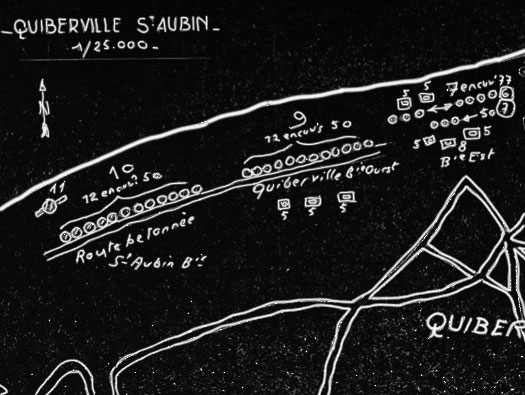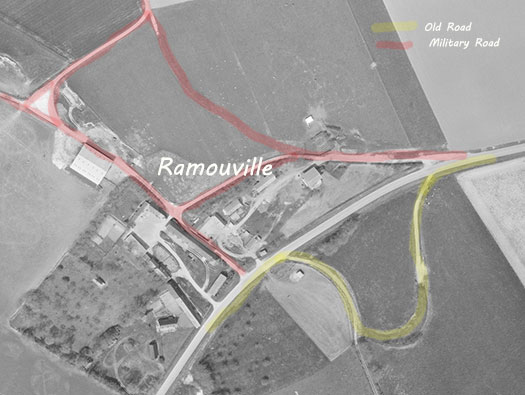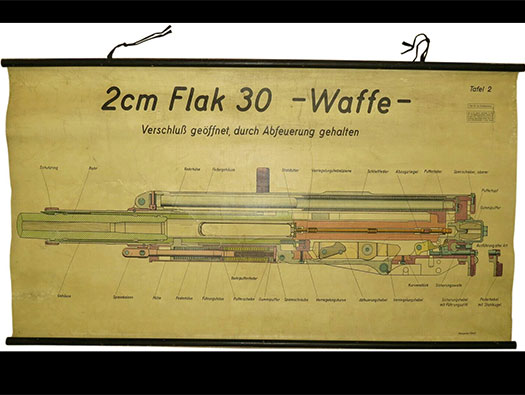Luftwaffe Flakschule Ramouville

Information
Luftwaffe Flakschule Ramouville
Details
Ramouville and its farm may have been the barracks of the Luftwaffe Flakschule and the farm buildings used as instruction for the Flak crews. The high cliffs with a concrete road connecting all the individual Ständiger Ausbau. (fully fortified position).They had ready ammunition slots around the outside. A plane would fly along the coast towing a Drogue behind it and the guns would attempt to fire at the moving target (not the plane). The aircraft could have been W 34, Ju 52, Heinkel 70 and He 111.

Junker W34

Heinkel 70 Blitz Bomber.

He 111 bomber.
Luftwaffe Flakschule Ramouville
Information
Luftwaffe Flakschule Ramouville
Details
Luftwaffe Flakschule Ramouville

REMONTER LE TEMPS
Information
Luftwaffe Flakschule Ramouville
Details
Where some of the remains may be found.

Unterstand

Unterstand.

OB Flak.
Luftwaffe Flakschule Ramouville

11 August 2007
Information
Luftwaffe Flakschule Ramouville
Details
The village of Quiberville and the cliffs beyond are where the Flak School was. We walked at low tide along the sea shore and then back via the D75.

Luftwaffe.

M43 Cap.

Luftwaffe Flak Artillery Award.
Luftwaffe Flakschule Ramouville

11 August 2007
Information
Luftwaffe Flakschule Ramouville
Details
Now looking back from Wn Marg05 at Saint-Aubin-sur-Mer. You can see bits of Flak bunkers down on the beach even from here.

Bits on the beach.

Bits still in the cliff edge.
Luftwaffe Flakschule Ramouville

Geoportail
Information
Luftwaffe Flakschule Ramouville
Details
5 - Abri = Shelter.
6 - 7 encuve = 7 Vats (open emplacements Flak).
7 - 3 encuve = 5 Vats (smaller? open emplacements Flak).
8 - Abri entrerre = Shelter entry.
9 - 12 encuve = 12 Vats (smaller? open emplacements Flak).
10 - 12 encuve = 12 Vats (smaller? open emplacements Flak).
11 - PD de tir = Fire control observation.
Luftwaffe Flakschule Ramouville




Geoportail ---------------------------------------------------------------- 3 x NARA
Information
Luftwaffe Flakschule Ramouville
Details
The air photo shows the road and the Flak emplacements very well, but I am not entirely sure what each item was. The sea has washed away many of these bunkers and any that it has not, are getting very close to the edge. The dotted line I really cannot understand, its not a road but looks like straw/hay ricks. Which seems wrong, or they could be ammunition stacks. But that also seems silly as an explosion in one would set them all off. Unless they are concrete construction and are ammunition storage bunkers. .
Several details are from "Flak - from a modeler's viewpoint".
9th USAAF 18 June 1945.

Ammunition storage?

Ammunition storage?
Luftwaffe Flakschule Ramouville

Unknown
Information
Luftwaffe Flakschule Ramouville
Details
Heavy Flak on the northern end of the site. I have said here on the SHM plan that I thought that 10.5cm & 7.5cm Flak was used here, but this does look like these are 8.8cm Flak.
Luftwaffe Flakschule Ramouville

11 August 2007
Information
Luftwaffe Flakschule Ramouville
Details
A trench or a covered command wire to an AA emplacement. Each gun position would have been linked via a field telephone to a training Officer who would give fire orders and also for safety. A plane would come into view and the training Officer would then order the guns to fire on the drogue being towed by the plane.

A British Hawker Henley TT towing a drogue target. From No. 1 Anti-Aircraft Co-operation Unit (AACU)

Armoured cable (British RAF).

Armoured cable found on a Normandy gun site.
Luftwaffe Flakschule Ramouville

11 August 2007
Information
Luftwaffe Flakschule Ramouville
Details
One of the first group of AA positions. In my opinion there seems to be three types of guns used here 105cm Flak, 75cm Flak (pos. French captured guns) and 2cm Flak. This one looks like a 7.5cm size.
Small excerpt from Forum Der Wehrmacht
"Flak firing range Stolpmünde To fly target representation for the anti-aircraft artillery on the anti-aircraft firing range Stolpmünde was the task of the tow pilots known to all stumblers. These were provided by an air service unit with offices in Stolp-Reitz and Vietzkerstrand. The land planes were stationed in Reitz and the seaplanes in Vietzkerstrand. The aircraft were: W 34, Ju 52, Heinkel 70 and He 111 and at the beginning of the war Martin bombers. It was a civil unit until the beginning of the war, later it became a military air force unit with the same mission. During the war, the command was greatly increased and continuously transferred pilots, flight mechanics and radio operators to front-line units. The technical staff was under the direction of Obermeister Rotke, the command leader was based in Vietzkerstrand.
(Italics - place names).

10.5cm Flak.

7.5cm M32 (f) Flak.

2cm Flak 30.
Luftwaffe Flakschule Ramouville

11 August 2007
Information
Luftwaffe Flakschule Ramouville
Details
The edge of an emplacement. Possibly a drain hole to allow water out.
'Flak' stands for Flieger Abwehr Kanonen: no word was more dreaded among Allied bomber crews than this during the air war between 1939 - 45.

Flak 30 manual.

Wall charts for a 2cm Flak 30.

Wall charts for a 2cm Flak 30.
Luftwaffe Flakschule Ramouville

11 August 2007
Information
Luftwaffe Flakschule Ramouville
Details
An underground (Unterstand) shelter of some kind.
Luftwaffe Flakschule Ramouville

11 August 2007
Information
Luftwaffe Flakschule Ramouville
Details
Command cables hanging off the cliff.

Armoured cable found on a Normandy gun site.
Luftwaffe Flakschule Ramouville

11 August 2007
Information
Luftwaffe Flakschule Ramouville
Details
We are now half way along the sea shore.
Luftwaffe Flakschule Ramouville

11 August 2007
Information
Luftwaffe Flakschule Ramouville
Details
Now another half way to go.
Luftwaffe Flakschule Ramouville

11 August 2007
Information
Luftwaffe Flakschule Ramouville
Details
The second half with 10 x 2cm Flak positions.

Thunderbolt.

Thunderbolt.
Luftwaffe Flakschule Ramouville

11 August 2007
Information
Luftwaffe Flakschule Ramouville
Details
2cm position.
Preparing the Flak gun for action followed the below order:
1. Remove the tarpaulin and the muzzle cover.
2. Dismount the gun from its carriage.
3. Level the gun.
4. Unlock the travel locks.
5. Install the sighting mechanism.
6. Prepare the ammunition.
7. Load the weapon.

A gun it traveling mode with covers on.

Coming into action.

Fire.
Luftwaffe Flakschule Ramouville

11 August 2007
Information
Luftwaffe Flakschule Ramouville
Details
Part of the Flakschule road.

The road.
Luftwaffe Flakschule Ramouville

11 August 2007
Information
Luftwaffe Flakschule Ramouville
Details
The end of a trench system.

Trench from above.
Luftwaffe Flakschule Ramouville

11 August 2007
Information
Luftwaffe Flakschule Ramouville
Details
Pieces of Flak positions now lying on the beach.
Against aerial targets, it can be bought into action as a barrage weapon or by using direct fire. Barrage fire means that the gun/guns are firing into a specific area or 'box' of airspace. The box is predicted by the gun/battery commander to be at the same height as and within the plane’s flightpath. Direct fire means that the gun is aimed directly at the enemy aircraft (or in its flight path depending on the angle and speed of the enemy aircraft).
Training manual.
Luftwaffe Flakschule Ramouville

11 August 2007
Information
Luftwaffe Flakschule Ramouville
Details
Base for a Flak gun to sit on.

Designs for the bases of a 2cm Flak gun.

2cm Flak gun.

Tool kit.
Luftwaffe Flakschule Ramouville

11 August 2007
Information
Luftwaffe Flakschule Ramouville
Details
Concrete slabs from the roadway and a triangular steel sheet with rivets around the edge.

Tools.
Luftwaffe Flakschule Ramouville

11 August 2007
Information
Luftwaffe Flakschule Ramouville
Details
How a 2cm Flak gun could sit on a plinth and not bounce off, I have no idea how.
1. Feldmässig. The gun is deployed on an open road or in a field without any construction around it, if the situation requires it to stay on its carriage.
2. Feldmässiger Ausbau. The gun is taken off the carriage and a berm of earth, sand, snow, stones,sandbags, logs or similar is erected around the guns position.
3. Verstärkter Feldmässiger Ausbau. A parapet of wood, timber, light concrete or bricks is erected around the gun's position. Extensive work is also put into sheltering both the gun and the crew against attack and the elements.
4. Ständiger Ausbau. The gun is placed in a fully fortified position either on a heavy concrete gun platform or in a bunker.

Designs for the bases of a 2cm Flak gun.

2cm Flak gun.

The chassis of a 2cm Flak showing how it fits on a plinth.
Luftwaffe Flakschule Ramouville

11 August 2007
Information
Luftwaffe Flakschule Ramouville
Details
Another in more pieces.
Luftwaffe Flakschule Ramouville

11 August 2007
Information
Luftwaffe Flakschule Ramouville
Details
This one must have landed at high tide and its fall was cushioned so it did not break up.

Magazines.

Magazine.
Luftwaffe Flakschule Ramouville

11 August 2007
Information
Luftwaffe Flakschule Ramouville
Details
Stones were hurriedly put in to stop it floating away.
You can see the ready ammunition niches around the outside.
Not only anti aircraft gun and firing would have been taught here, but range finding, observation, armourer7mechanics, ammunition specialists, crew & drivers.

Ammunition.

Rangefinder.

Analogue rangefinder computer.
Luftwaffe Flakschule Ramouville

11 August 2007
Information
Luftwaffe Flakschule Ramouville
Details
A large part of the road missing.

Blitz wagon to deliver ammunition.
Luftwaffe Flakschule Ramouville

11 August 2007
Information
Luftwaffe Flakschule Ramouville
Details
This maybe an unterstand like the earlier one we saw.

Earlier unterstand.
Luftwaffe Flakschule Ramouville

11 August 2007
Information
Luftwaffe Flakschule Ramouville
Details
A door entrance.
Luftwaffe Flakschule Ramouville

11 August 2007
Information
Wn Marg05 (Luftwaffe Flakschule Ramouville)
Details
This is Wn Marg05 and nothing to do with the Flakschule except that its the path back off the beach.
Luftwaffe Flakschule Ramouville

11 August 2007
Information
Luftwaffe Flakschule Ramouville
Details
The cliff walk is prohibited and you can understand why.
Luftwaffe Flakschule Ramouville

Geoportail 1945
Information
Luftwaffe Flakschule Ramouville
Details
The route we walked. Along the beach and then climbing up the cliff at Wn Marg05 and then taking the military road and then the D75 back.

He70.
Luftwaffe Flakschule Ramouville

11 August 2007
Information
Luftwaffe Flakschule Ramouville
Details
The Flak roadway.

Opel Blitz Wagon.
Luftwaffe Flakschule Ramouville

11 August 2007
Information
Luftwaffe Flakschule Ramouville
Details
The Flak roadway.
Luftwaffe Flakschule Ramouville


11 August 2007
Information
Luftwaffe Flakschule Ramouville
Details
The Flak roadway through the farm at Ramouville.

Barrack hut.
Luftwaffe Flakschule Ramouville

11 August 2007
Information
Luftwaffe Flakschule Ramouville
Details
The Flak roadway through the farm at Ramouville.
I would think the farm was the HQ of the
Flakschule or a large house close by and the farm could be made into barracks, training and repair workshops.
Luftwaffe Flakschule Ramouville

11 August 2007
Information
Luftwaffe Flakschule Ramouville
Details
Now on the D75 and this is the middle Flakschule roads leading to the cliff road.
Luftwaffe Flakschule Ramouville

Google
Information
Luftwaffe Flakschule Ramouville
Details
This is the edge of Quiberville village where the first roadway starts.
Luftwaffe Flakschule Ramouville

Web
Information
Luftwaffe Flakschule Ramouville
Details
 Norway (coming soon!)
Norway (coming soon!)
 France
France
 Great Britain
Great Britain







































































































